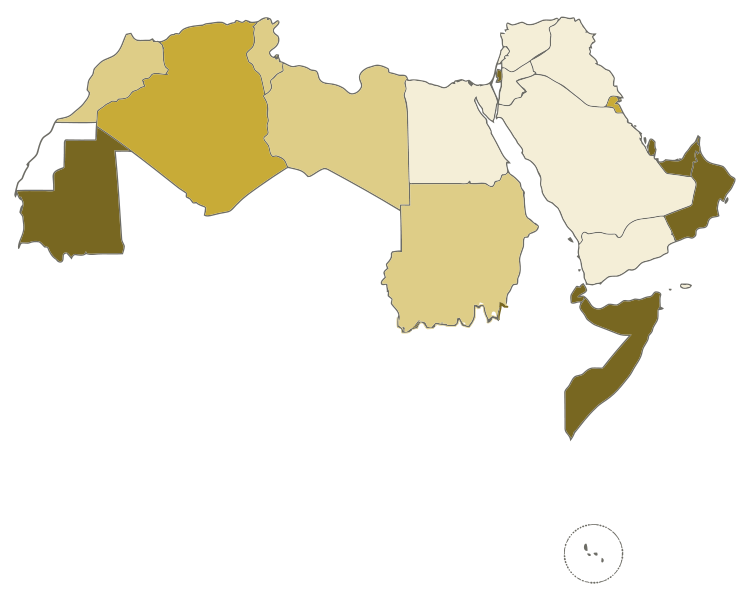
Views: 123
What is Arab?
Understanding Arab culture and the values based on it are the crucial points for the proper understanding of the modern region of MENA (composed of the Middle East and North Africa) and its fundamental features. Nevertheless, it must be noticed that all people in the region of MENA are not Arabs like Turks, Jews, some North African tribes, or Iranians. The Arab League (or the League of Arab States) is composed of 22 Arab countries. Even though Arab states are, in fact, from a very cultural viewpoint considered to be Middle Eastern (in a broader sense), not all of them belong to the Middle East (in a narrow sense), and not all Middle Eastern or MENA countries are Arab.
Another focal feature of the Arab world is that not all member states have similar attitudes, communications, behaviors, traditions, etc. There are, for instance, Muslim Arab states such as Mauritania, Sudan, or Somalia in which tribal languages are usually spoken rather than Arabic followed by many cultural traditions founded on the local African customs and heritage.
We also have to keep in mind the very fact that not all Arabs are Muslims as there are those Middle Eastern Arabs who are Christians (in Lebanon, for instance). However, the Arab nations are composed of an overwhelming Muslim (Sunni or Shia) majority. The next feature we have to take about is that Arabs are an ethnic category of broader Semitic people (Jews are Semites too), while the term Muslim determines religious belief and confessional orientation. Nonetheless, the reference to Arabs is, basically, directed to separate people who possess a unique pattern of behaving founded on their special type of culture, tradition, religion, language, and customs. However, the Arab people do not all look or dress alike and should not be stereotyped. It has to be stressed that Arabs are not a race, skin color, nationality, or Muslim. By the authentic pre-Islamic time, an Arab was an inhabitant of the Arabian Peninsula, a member of some of many nomadic Bedouin tribes but at the time of the expansion of Arabian Islam, Arabs brought their new religion, language, and culture to the region of the Middle East and North Africa and beyond (like to the Iberian Peninsula), mixing it with the conquered peoples from Spain and Portugal to Persia.
Arab conquests have been the wars which in the century after the death of the Prophet Muhammad in 632, created a great state (caliphate/empire) which was stretching from the Pyrenees in Europe to the Indus River in Asia. The conquest originally started as a holy war (jihad) against those Bedouin tribes who refused to accept Islam but soon the holy war became inspired by the prospect of vast land acquisition and the belief that death in the holy war would bring the warrior to paradise. In the Byzantine provinces of Egypt and Syria, the Arab conquerors allowed Christians and Jews to continue expressing their confessions as the “peoples of the book” or “protected peoples” (dhimmi) upon payment of a certain tax. Due to the resistance in Persia and North Africa, the conquests became slower. After the first civil war in 656−661, the Arab capital was transferred from Medina to Damascus by the dynasty of Umayyads and under the new dynasty of Abbasids to Baghdad where Islamic culture flourished. Regardless of the fact that the political coherence of this Arab empire (historically there were four caliphates) no longer existed due to the rival caliphates appearing in North Africa and the Iberian Peninsula in the 9th and 10th centuries, cultural coherence was maintained by the university of the Arab language and Islamic law (shariah) followed by the traffic of merchants, scholars, and pilgrims.
As a consequence of the Arab conquests followed by the intermixture of Arabic with local cultures, today, in fact, Arabs are not some separate ethnic group but much more a community with a state of mind. The confusion about the meaning of the term Arab is coming very often from the fact that it is used as a synonym for the peoples of MENA or/and Muslims in general. However, the question is what are the crucial characteristics of the distinctive Arab culture?
The focal features of Arab culture
Like any distinctive culture, Arab culture has its own values – Arab values (as, for instance, Asian values). In Arab traditional societies, the most valuable virtues are respected to be dignity, honor, and reputation. It is, for instance, very much suggested to foreigners in an Arab country to avoid causing an Arab to lose face or to be shamed; in the case of a woman, for losing her virginity before the marriage. There has to be respected Arab loyalty to family and polite and friendly communication. In tribal or traditional Arab communities, the scale of priorities runs first to the individual, then kinsman, tribesman, and finally to those who share the same confession and country. Regardless of the rapid urbanization which decreased the influence of tribalism, there is still a degree of collectivism. However, the focal problem is taking into consideration all aspects of the impact of modernization, for how long local Arab community can be successful in the preservation of their traditional characteristics of generosity, gallantry, courage, patience, and endurance, especially at the time of the false stereotypes about Arabs created by Western mass media, film, and TV industry.
The effects of Western colonialism, cultural, and military invasions in the Arab MENA societies caused serious changes at a high price like: 1) Urban problems such as inadequate housing and traffic organization; 2) Weakened parental authority and family cohesion; 3) Poverty for the masses and affluence for the elite; or 4) Broken homes, materialism, and sexual promiscuity. The outcome of such Westernization’s impact on MENA has been manyfold:
- Islamic traditionalists are propagating the struggle against what they understand to be Western civilizational decadence followed by the increase of immorality. They reject Western (liberal) democracy as not fitting traditional Islamic culture as individual freedom above collective responsibility, the rights of women according to Western standards including their full education, and many other practices that are common in (post)industrialized nations. The Islamic fundamentalists or extreme traditionalists are seeking to form the governmental authorities according to the ancient (authentic) Islamic law based on the Qur’an. Most extremist groups are organizing violent attacks against Western values, culture, and Western foreigners including tourists as well.
- Several governments of MENA states have responded to Islamic traditionalists with both harsh and authoritarian security measures including treating all dissidents in their countries as terrorists. This happened, for instance, in Algeria or Egypt, where attempts by the people to democratically elect an Islamic government have been suppressed by the ruling power very much supported by Western (the USA) authorities.
- Western bombings, killings, and devastations of Arab Muslim countries in the name of liberal Western democracy during the last 33 years caused the rise of Islamic fundamentalism in the Middle East and around which may provoke as S. P. Huntington wrote the “Clash of Civilizations” or more precisely a focal war between Arab and other Muslim societies against the Judeo-Christian Western order.
- There are those on both sides who despite all differences in confession, culture, values, history, or customs believe in reconciliation and understanding between the Judeo-Christians and the Arab Muslims. However, such cultural differences and even antagonistic divides may only be overbridged if local authorities and business leaders become more sensitive and less assertive concerning the (Arab) Islamic ethos and aspirations. It is suggested that the most optimal places to start the creation of greater cultural cooperation with the (Arab) Muslim communities are Western countries from both sides of the Atlantic Ocean, especially after 9/11 when hate crimes surged in the West against innocent Muslims.
One of the focal features of Arab culture is that Arabs seek close personal relationships, mainly without great distance or mediators. Body and food odors are used to enhance relationships. The body is an important factor in the process of choosing a partner. For Arabs, to look at one peripherally is a not polite way. On one hand, the Arabs are not looking for personal distance if interacting with friends but they may seek far personal distance in conversation with strangers and on such social occasions, for instance, Arabs may prefer to sit on opposite sides of a room and talk across to one another. Arabs are generally warm and expressive people being active participants with each other but they resist being crowded in enclosed spaces or by boundaries. Cordiality is the core of Arab culture. The traditional greeting is to place one’s right hand on the chest near the heart as a sign of sincerity although modern Arabs may proceed with greeting with a long, limp handshake. There is a custom for men to kiss one another on both cheeks. For Arab Muslims, certain Islamic teaching affects very much social relations as, for example, taboos against eating pork meat, drinking alcohol, or gambling.
The social position and role of Arab women are some of the most special features of Arab culture at least to be compared with the Western culture. In principle, great diversity exists in the Arab world regarding the status of women in both family and society. It is a fact that the Arab patriarchal culture places the male in the dominant position and role, while the protection and respect of women are the common rules. In an Arab household, the husband is the head with a strong role and influence but the woman as a mother is very often the authority on family matters.
In public life, the woman defers to her husband, but in the private sphere, she is more influential. It has to be stressed that, paradoxically, Islam does not advance the practice of female inherent inferiority, but only female differences. Islam does not perceive biological inferiority but instead, affirms potential equality between males and females.
It is true that in some Arab states, female members of the family are equal to the males but in others, they have only a limited role in the family and a restricted position in the society. In more conservative and traditional Arab communities men are allowed to have up to five women, including the foreign-born while women may marry only one husband, excluding foreigners. In Arab society, the husband may divorce without indicating a real cause but the wife is obliged to specify the foundations of divorce in order to satisfy the court which recognizes the testimony of two females to be equal to one male witness.
In the Qur’an is not written that women must be veiled as it is just written that they have to be dressed modestly in appearance by covering their arms and hair, which are considered to be very sensual from the viewpoint of morality. It is important to emphasize that Western females (or in general, foreign females – those of not Arab and Islamic origin) visiting Arab countries have to pay great attention to what is acceptable or unacceptable in the local Arab Islamic community of visitation. Whether being a simple visitor-tourist or some kind of business person, women have to accommodate themselves to what is considered allowed and proper behavior and be adequately dressed according to the local moral rules. The persons from outside the culture who do not respect local Arab moral rules, either male or female, may have unpleasant experiences either with the members of the local community or the court.
Nevertheless, the traditional Arab way of life is undergoing substantial changes in social, political, economic, and religious aspects. Cultural and moral practices may vary depending on the degree of secularization and economic development followed by the impact of education and modernization.
Anti-Western reactions by MENA Arabs
The Arabs of MENA have long suspicion of former European colonial powers but above all the French and British who have been ruled the biggest portion of the region. Many Westerners have negative images and stereotypes about Middle Easterners and North Africans and their cultural contributions to the history of global civilization but it is true, especially regarding West European and North American mass media’s presentation about MENA and Arabs. However, after 9/11, aggressive US politics toward the region of MENA regarding its people, culture, and religion, became the foundation of anti-Western politics by the Middle Easterners and North Africans that declined both political and business relationships between MENA and the West.
Such a process occurred in Iran which is a non-Arab country/nation, in 1979 when the US influence and political/military actions brought to the question the identity of Persian/Iranian culture to the point of a violent takeover of and hostage-taking at the US Embassy in Tehran. Nevertheless, we have to keep in mind that the Muslim terrorist actions among Islamic radicals arose primarily out of fear that Western cultural values would destroy traditional Arab culture. The results of an influx of Westerners into the region of MENA can be summarized from the Arab perspective as such:
- The Westerners express their alleged civilizational superiority followed by arrogance.
- The Westerners know the best answers to everything.
- Many Westerners do not want to share the credit for what is accomplished by joint efforts.
- The majority of Westerners are constantly unable or even unwilling to respect and adjust to local Arab customs and cultural traditions.
- Many Westerners fail to innovate to meet the needs of local Arab culture, preferring to seek easy solutions founded on the conditions in their native countries.
- Westerners are often too imposing, aggressive, pushy, and rude.
- What makes Arabs very mad is the fact that the Americans and West Europeans are constantly providing much more financial aid and material support for Zionist Israel than for the Arab Palestinians and their human rights.
Finally, there are four proposals of possible peaceful cooperation between the people of MENA region and the Westerners which can contribute to solutions to current challenges in the Middle East and North Africa:
- The reconstruction of both Iraq and Afghanistan in the direction that their citizens would meet fundamental human rights, freedom, and dignity.
- The resolution of warfare between the Zionist Israel and the local autochthonous inhabitants of Palestine – Arab Palestinians.
- The resolution of the internal disputes between al-Fatah and Hamas.
- The modernization of socio-political-economic systems in MENA.
Ex-University Professor
Research Fellow at Centre for Geostrategic Studies
Belgrade, Serbia
www.geostrategy.rs
sotirovic1967@gmail.com
© Vladislav B. Sotirovic 2024
Personal disclaimer: The author writes for this publication in a private capacity which is unrepresentative of anyone or any organization except for his own personal views. Nothing written by the author should ever be conflated with the editorial views or official positions of any other media outlet or institution.
Originally published on 2024-01-27
Origins of images: Facebook, Twitter (X), Wikimedia, Wikipedia, Flickr, Google, Imageinjection, Public Domain & Pinterest.
Read our Disclaimer/Legal Statement!
Donate to Support Us
We would like to ask you to consider a small donation to help our team keep working. We accept no advertising and rely only on you, our readers, to keep us digging the truth on history, global politics, and international relations.
FOLLOW US ON OUR SOCIAL PLATFORMS










